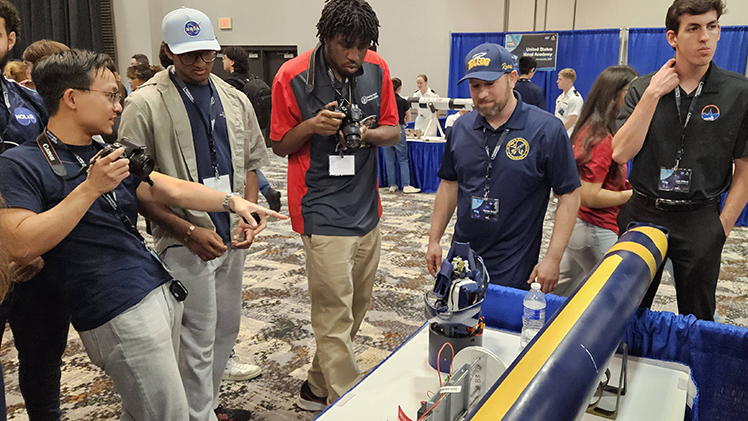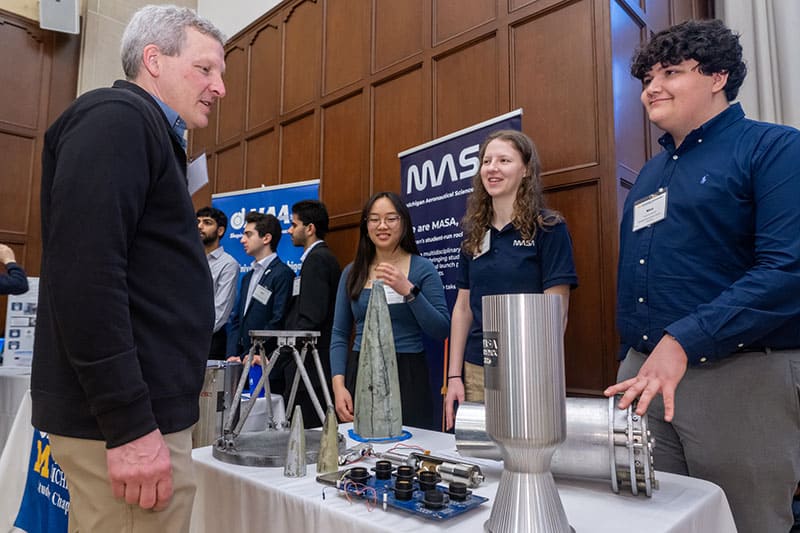The NASA Student Launch Challenge: Shaping the Future of Aerospace Engineering The NASA Student Launch Challenge is a prestigious competition that brings together the brightest minds in aerospace engineering from across the United States. Since its inception in 2000, this annual event has been providing a platform for students to design, build, and launch their own rockets, while fostering innovation, creativity, and collaboration. The Purpose of the Challenge The primary objective of the NASA Student Launch Challenge is to inspire and motivate students to pursue careers in the fields of science, technology, engineering, and mathematics (STEM). By providing a hands-on, real-world experience, the challenge encourages students to develop essential skills in engineering design, project management, and teamwork. The competition also aims to promote research and development in the aerospace industry, driving innovation and advancing the state-of-the-art in rocketry and space exploration. Significance in Shaping the Future of Aerospace Engineering The NASA Student Launch Challenge plays a vital role in shaping the future of aerospace engineering in several ways:
- Developing the Next Generation of Aerospace Engineers: By engaging students in the design, development, and launch of rockets, the challenge helps to develop the skills and expertise required to tackle the complex challenges facing the aerospace industry.
- Fostering Innovation and Creativity: The competition encourages students to think outside the box, pushing the boundaries of what is possible in rocket design and development.
- Advancing Aerospace Technology: The challenge drives innovation in areas such as propulsion systems, materials science, and autonomous systems, contributing to the advancement of aerospace technology.
- Building a Skilled Workforce: By providing students with hands-on experience and exposure to real-world challenges, the NASA Student Launch Challenge helps to build a skilled and knowledgeable workforce, equipped to tackle the complex challenges facing the aerospace industry.

What is the NASA Student Launch Challenge?
- Designing and building complex systems
- Applying theoretical knowledge to real-world problems
- Collaborating as a team to achieve a common goal
- Developing problem-solving and critical thinking skills
- Understanding the importance of safety and risk management in aerospace engineering
- Enhanced career prospects in the aerospace industry
- Development of skills and knowledge that are highly valued by employers
- Opportunities to network with industry professionals and like-minded students
- Access to cutting-edge technology and resources
- Increased confidence and motivation to pursue a career in aerospace engineering

Eligibility and Participation
- Students must be enrolled in a Bachelor's or Master's degree program.
- Students must have a minimum cumulative GPA of 3.0 or equivalent.
- Students must be in good academic standing with their institution.
- Teams must have at least one member with a technical background (e.g., computer science, engineering).
- Teams must have at least one member with a business or marketing background.
- Teams can have additional members with other relevant skills, such as design or finance.
- Initial Application: February 15th
- Final Application: March 15th
- A completed application form, which includes team member information and academic background.
- A project proposal, outlining the team's idea and approach to the competition's theme.
- A resume for each team member, highlighting relevant skills and experience.
- A letter of recommendation from a faculty advisor or industry professional.

Competition Phases and Judging Criteria

Prizes and Benefits
- $10,000 for the first-place team
- $5,000 for the second-place team
- $2,000 for the third-place team
- A three-month internship with a leading tech firm
- A six-month internship with a renowned startup accelerator
- A one-year internship with a prominent research institution

Frequently Asked Questions (FAQ)
Who can participate in the NASA Student Launch Challenge?
The NASA Student Launch Challenge is an exciting opportunity for students to design, build, and launch their own rockets, gaining hands-on experience in STEM fields. But who can participate in this thrilling competition? Eligible Student Teams The NASA Student Launch Challenge is open to student teams from middle school to university level. This means that students from a wide range of educational backgrounds can participate, from young minds in middle school to advanced students in university programs. Team Composition To participate in the challenge, teams must consist of a minimum of three students. This collaborative approach encourages teamwork, communication, and problem-solving skills, all essential for success in the aerospace industry. In addition to student team members, each team must also have a faculty advisor who serves as a mentor and guide throughout the competition. Role of the Faculty Advisor The faculty advisor plays a crucial role in the NASA Student Launch Challenge. They provide guidance and support to the student team, helping them to navigate the competition and ensure that their project meets the required standards. Faculty advisors can be teachers, professors, or other educators who are affiliated with the students' educational institution. Benefits of Participation By participating in the NASA Student Launch Challenge, students can gain valuable experience in rocketry, engineering, and scientific research. They will also have the opportunity to work with NASA engineers and scientists, gaining insight into the latest developments in the field. Furthermore, the competition fosters critical thinking, creativity, and collaboration, essential skills for success in STEM careers. Getting Started If you're a student or faculty advisor interested in participating in the NASA Student Launch Challenge, here's how to get started:
- Form a team of at least three students and a faculty advisor.
- Review the competition rules and requirements.
- Develop a project proposal and submit it to NASA.
- Work together as a team to design, build, and test your rocket.
- Launch your rocket and present your results to NASA engineers and scientists.
What is the timeline for the 2026 NASA Student Launch Challenge?
The NASA Student Launch Challenge is an annual competition that provides undergraduate and graduate students with the opportunity to design, build, and launch a payload into the atmosphere, while gaining valuable hands-on experience in engineering, science, and project management. As the competition approaches, teams must stay on track to meet the various deadlines and milestones. Here is a detailed timeline of the 2026 NASA Student Launch Challenge: Application and Registration Phase (August 2025 - October 2025) During this phase, teams must submit their application packages, which include a proposal outlining their project concept, team composition, and budget. The application package must be submitted through the NASA Student Launch Challenge online portal. Review Phase 1 (October 2025 - November 2025) A panel of reviewers from NASA and industry experts will evaluate the submitted applications based on criteria such as technical merit, innovation, and feasibility. Teams that pass this review phase will be invited to proceed to the next phase. Design and Development Phase (November 2025 - February 2026) Selected teams will develop their payload and launch vehicle designs, and submit periodic progress reports to NASA. During this phase, teams will also participate in virtual reviews and design critiques with NASA experts. Review Phase 2 (February 2026 - March 2026) Teams will submit their final design reports, which will be reviewed by NASA experts. This review phase will assess the teams' design maturity, technical readiness, and compliance with safety and performance requirements. Critical Design Review (CDR) and Flight Readiness Review (FRR) (March 2026 - April 2026) Teams that pass Review Phase 2 will participate in a Critical Design Review (CDR), where they will present their designs to a panel of NASA experts. Following the CDR, teams will also undergo a Flight Readiness Review (FRR) to ensure their vehicles are safe for launch. Launch Preparations and Integration (April 2026 - May 2026) Teams will integrate their payloads and launch vehicles, and conduct final checks and tests. NASA will provide guidance and support during this phase to ensure a smooth and safe launch. Launch Event (May 2026) The launch event will take place at the Bonneville Salt Flats in Utah, where teams will launch their vehicles and payloads into the atmosphere. The launch event will be attended by NASA officials, industry experts, and media representatives. Post-Launch Review and Award Ceremony (June 2026) After the launch event, teams will submit a post-launch report, which will be reviewed by NASA experts. The review will assess the teams' performance, payload recovery, and data analysis. The award ceremony will follow, where the winning teams will be announced and awarded. Here are some important dates to remember:
- August 2025: Application and registration opens
- October 2025: Application deadline
- November 2025: Review Phase 1 begins
- February 2026: Design and Development Phase ends
- March 2026: Review Phase 2 begins
- April 2026: Critical Design Review and Flight Readiness Review
- May 2026: Launch event
- June 2026: Post-launch review and award ceremony
How can student teams prepare for the NASA Student Launch Challenge?
Preparing for the NASA Student Launch Challenge requires dedication, hard work, and a strategic approach. As a student team, it's essential to start early, stay organized, and utilize available resources to ensure success. Here are some valuable tips and resources to help your team prepare for the challenge: Understand the Competition Requirements Before diving into preparation, familiarize yourself with the competition rules, guidelines, and requirements. NASA provides detailed documentation on their website, including the Competition Handbook and Rules and Requirements documents. Study these resources carefully to understand what's expected of your team. Online Tutorials and Resources Take advantage of online tutorials and resources to develop essential skills and knowledge. NASA offers a range of online tutorials and webinars on topics such as rocket design, payload development, and safety protocols. Additionally, websites like Khan Academy, Crash Course, and Coursera provide valuable learning resources on STEM-related subjects. Mentorship Opportunities Having a mentor can be a game-changer for your team. NASA provides a Mentorship Program that connects teams with experienced professionals from the aerospace industry. These mentors can offer valuable guidance, feedback, and support throughout the competition. Don't hesitate to reach out to them with questions or concerns. Practice Builds and Prototyping Practice builds and prototyping are crucial steps in the design and development process. They allow your team to test ideas, identify weaknesses, and refine your design. Allocate time and resources for multiple practice builds, and don't be afraid to experiment and try new things. Team Management and Communication Effective team management and communication are vital to success in the NASA Student Launch Challenge. Establish clear roles and responsibilities, set realistic goals and deadlines, and maintain open communication channels. Regular team meetings, progress tracking, and task assignments can help ensure everyone stays on track. Budgeting and Funding Develop a comprehensive budget and funding plan to support your team's activities. Identify potential expenses, such as materials, transportation, and equipment, and explore funding opportunities, like grants, sponsorships, and crowdfunding. Time Management and Scheduling Create a detailed schedule and timeline to ensure your team stays on track. Allocate time for design, development, testing, and documentation, and be prepared to adapt to changes and challenges as they arise. Additional Tips and Reminders
- Stay organized and keep detailed records of your team's progress.
- Conduct thorough research and testing to validate your design and development decisions.
- Practice presentation and documentation skills to effectively communicate your team's work.
- Attend NASA-sponsored events, workshops, and webinars to network with other teams and learn from industry experts.
- Stay up-to-date with the latest competition news, updates, and announcements from NASA.
Promoted
Massive ROI on Your Career: Resume Bundle for Only ₹99
A winning resume is worth thousands in salary. Our bundle of 4,400+ templates costs just ₹99. The ROI is massive.
🔥 Get Lifetime Access Now 🔥
